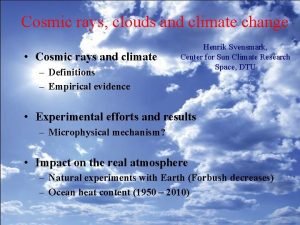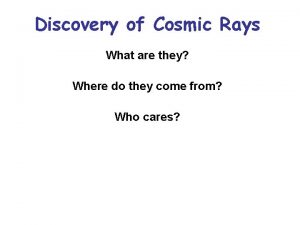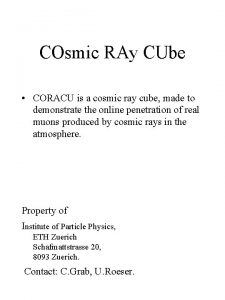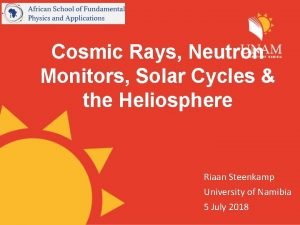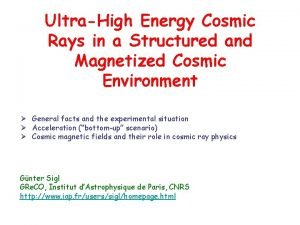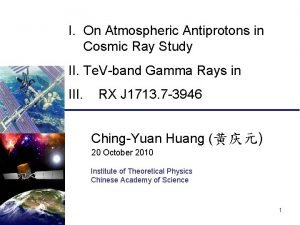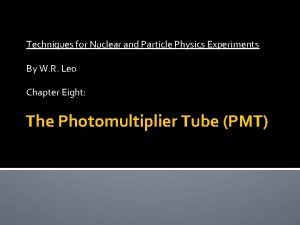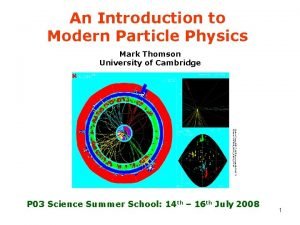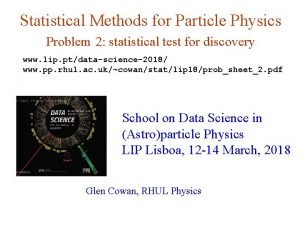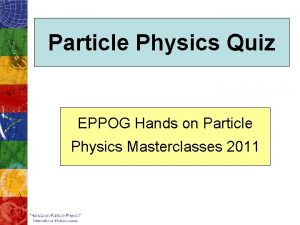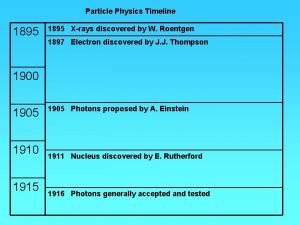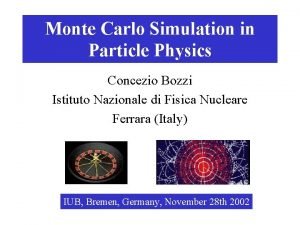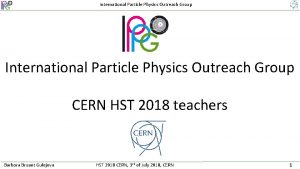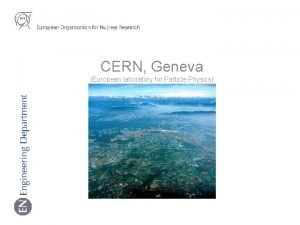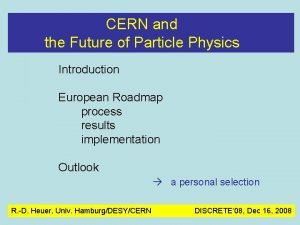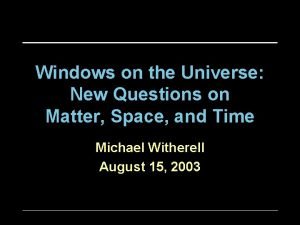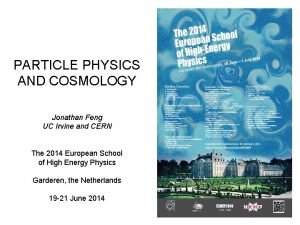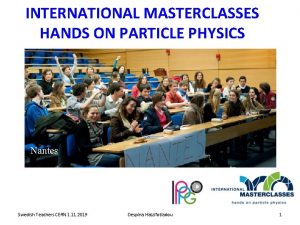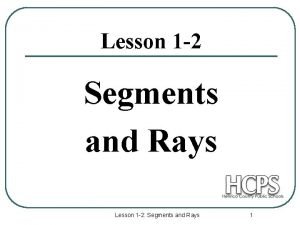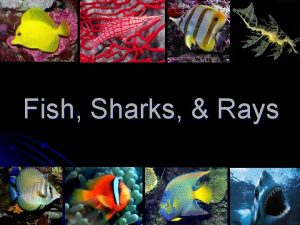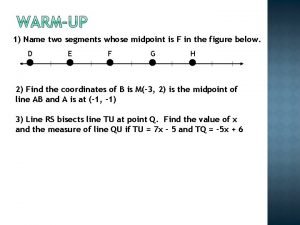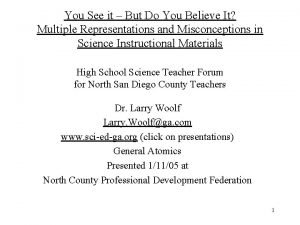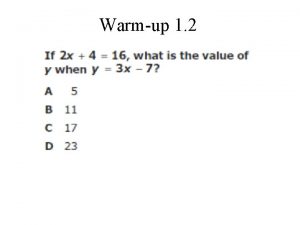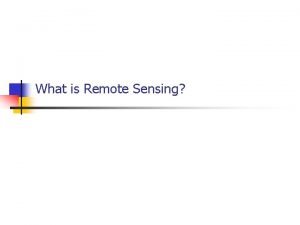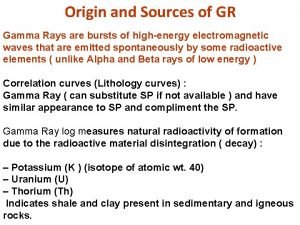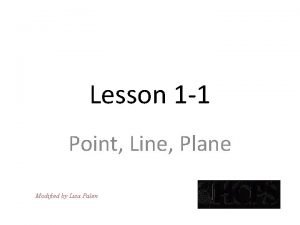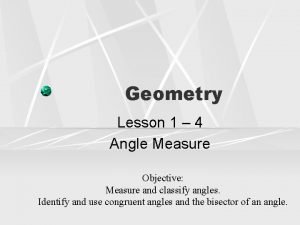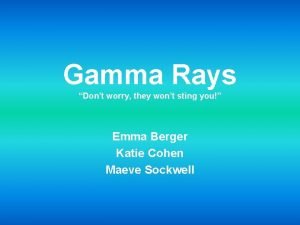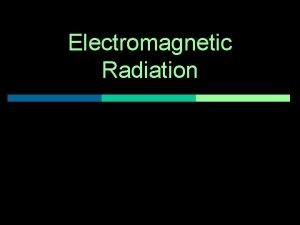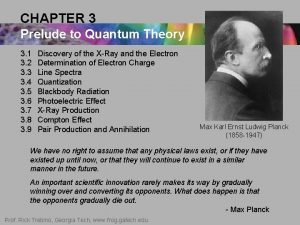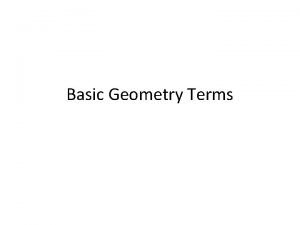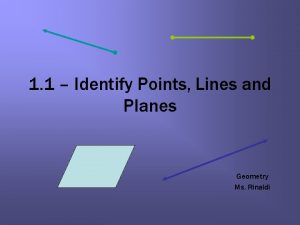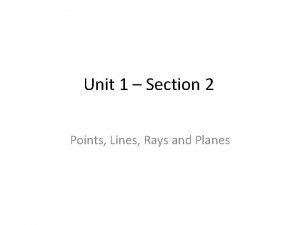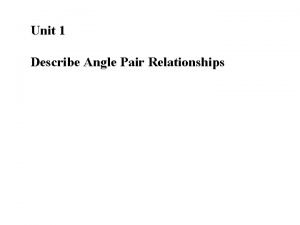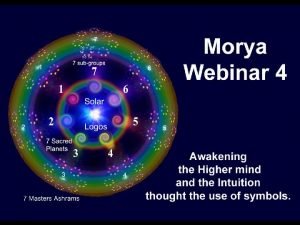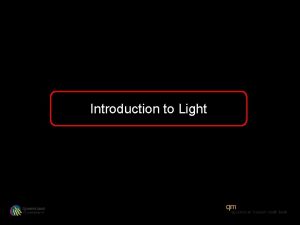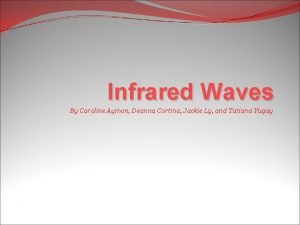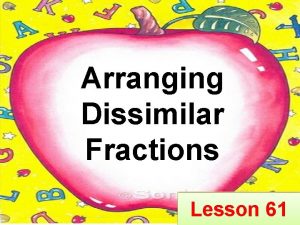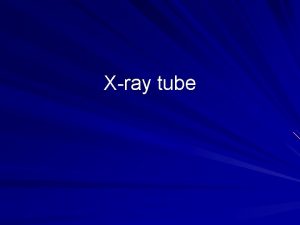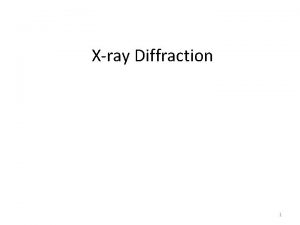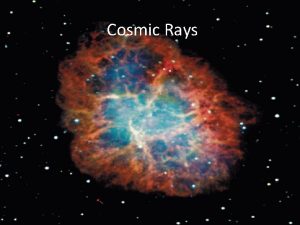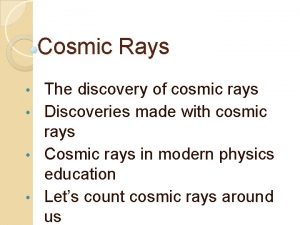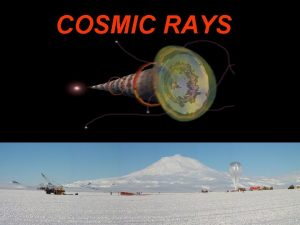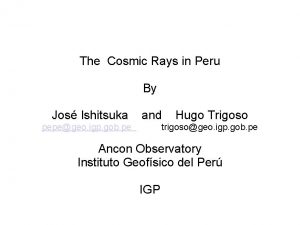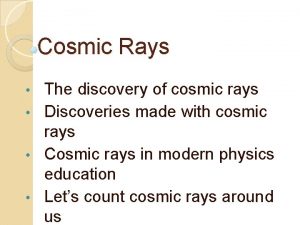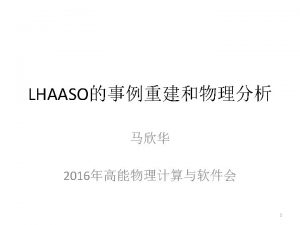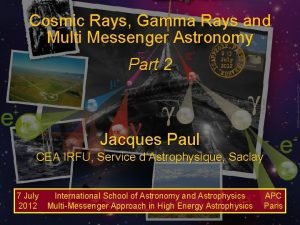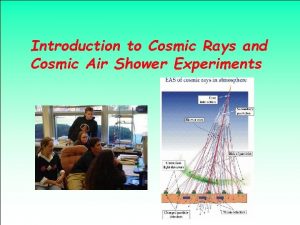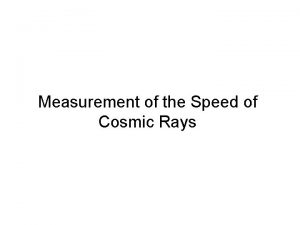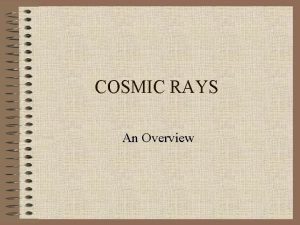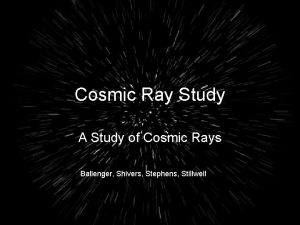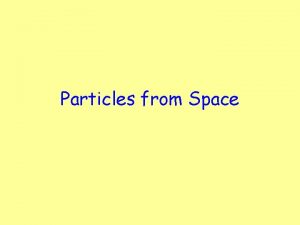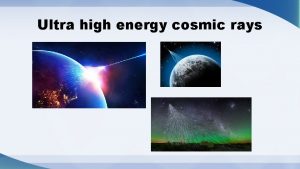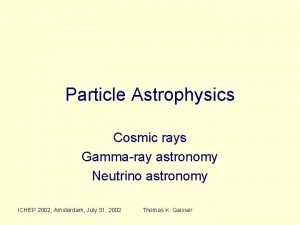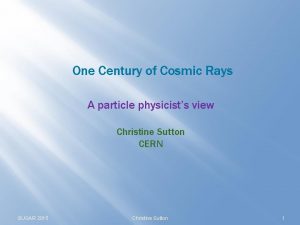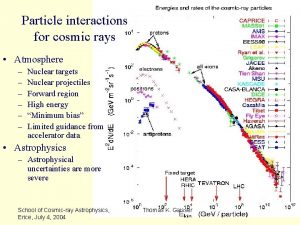Particle Physics Cosmic rays and particle generation Cosmic

















































- Slides: 49

Particle Physics

Cosmic rays and particle generation • Cosmic rays consist of high energy protons and nuclei emitted from stars including the Sun. • The protons strike gas atoms in the upper atmosphere and produce new short lived particles and antiparticles. • These new particles can be detected at ground level by cloud chambers and other detectors. • The first new particles to be detected were muons (1937), pions (1947) and kaons (1947).




Accelerators These enable more controlled conditions than occur with cosmic radiation interactions. High voltages are used to accelerate charged particles (electrons, positrons, protons and antiprotons) to near light velocities. The particles are made to collide into a stationary target or head-on with each other. The energy produced in these collisions can be used to create other particles. The largest linear accelerator is at Stanford in California which uses a 50 000 million volts (50 GV) to accelerate electrons over a distance of 3 km to an energy of 50 Ge. V. Linear particle accelerator game The largest circular accelerator is the Large Hadron Collider (LHC) at CERN near Geneva. This uses a circular tube of circumference 27 km within which protons and antiprotons are made to make head-on collisions at energies of up to 7000 Ge. V LHC Simulator LHC Rap

Hadrons and leptons HADRONS are particles that interact through the strong interaction examples: protons, neutrons, pions and kaons LEPTONS are particles that do not interact through the strong interaction examples: electrons, positrons, muons and neutrinos Leptons interact through the weak interaction. All charged particles interact through the electromagnetic interaction

Baryons and mesons • Baryons are hadrons that are protons or particles that eventually decay into protons. • The proton is the only stable baryon. • Neutrons are baryons because they decay into protons with a half-life of 12 minutes. Other baryons have much shorter half-lives. • Baryons are also called ‘fermions’ • Mesons are hadrons that do not include protons in their decay products. • All mesons are unstable • Examples of mesons include pions (π mesons) and kaons (K mesons)

Pions or π mesons can be positively charged (π+), negatively charged (π - ) or uncharged (π0). They have rest masses between the muon and proton (about 300 x the electron). They are all very unstable and decay by the weak interaction. • π+ decays into an antimuon and a neutrino • π - decays into an muon and an antineutrino • π0 decays into two high energy photons

Kaons or K mesons can be positively charged (K+), negatively charged (K- ) or uncharged (K 0). They have rest masses greater than pions but less than a proton (about 1000 x the electron). They are all unstable and decay by the weak interaction but far more slowly than pions. This relatively slow rate of decay (about 10 - 10 s) was unexpected and led to these particles being called ‘strange’ particles. Kaons decay into pions, muons and neutrinos.

A Kaon decaying into 2 Pi Mesons

Strangeness • This is a property possessed by some hadrons that has been assigned in order to explain why some particle interactions take place more slowly than others or do not occur at all. • The K + meson was the first particle with strangeness to be discovered and has been assigned a strangeness number (S) of +1 • Strangeness is a property, like charge, that is reversed in an antiparticle. Therefore the K - meson has strangeness of – 1.

Baryon number (B) baryons: (e. g. protons and neutrons) +1 antibaryons: (e. g. antiproton) -1 non-baryons (e. g. mesons and leptons) 0 Conservation of baryon number In all interactions the total baryon number is conserved.

Leptons • • Leptons are believed to be fundamental particles. This means that they do not decay into any other particles except other leptons. There are three families of leptons and antileptons. In order of increasing rest mass: 1. electrons and their neutrinos 2. muons and their neutrinos 3. tauons and their neutrinos • Only electrons and their neutrinos are stable.

Muons (μ ) • These are negatively charged like electrons but about 200 times more massive • There also exists the positively charged antimuon (μ+) • Muons are unstable and decay by the weak interaction into electrons and antineutrinos • Antimuons decay into positrons and neutrinos • Tauons are heavier versions of muons (about 20 x more massive).

Lepton and antileptons increasing mass → leptons anti-leptons antileptons electron, electron ee-- muon, muonμμ- tauon, tauonτ-τ - electron neutrino, neutrino vνe muon neutrino, neutrino νvμμ tauon neutrino, neutrino vτττ positron, positron ee+ + antimuon, antimuonμ+ μ+ antitauon, τ+τ antitauon electron muon tauon antineutrino, ve antineutrino, vμ antineutrino νe antineutrino νμ + antineutrino, vτ antineutrino ντ

Lepton number (L) leptons: (electrons, muons andand their neutrinos) antileptons: (positrons, antimuons andtheirantineutrinos) and non-leptons (e. g. hadrons and photons) non-leptons hadrons and photons) +1 +1 -- 11 Conservation of lepton number In all interactions the total lepton number is conserved. Lepton numbers are given in the examination 0

Complete: Answers: particle matter or antimatter hadron or lepton electromagnetic interaction ? baryon, meson or neither proton matter hadron yes baryon positron antimatter lepton yes neither K 0 matter hadron no no meson antineutrino antimatter lepton no neither muon matter lepton yes neither neutron matter hadron no no baryon

Particle overview matter and antimatter leptons hadrons baryons mesons

Interaction conservation rules All interactions must conserve: • ENERGY • CHARGE • LEPTON NUMBER & TYPE • BARYON NUMBER • and with strong interactions only: STRANGENESS

Energy and matter Accelerators such as the Large Hadron Collider increase the kinetic energy of particles involved in collisions. The total energy of the particles before the collision is equal to the rest plus kinetic energies of the particles. Likewise the total energy of the particles present after the collision. Using the conservation of energy: rest energy = total energy of the products before + kinetic energy of the products The smaller the final kinetic energy the better. This allows more energy to go into particle creation. Head-on collisions such as those with the LHC given the minimum final kinetic energy. LHC Simulator

Question A proton and an antiproton, both with 1. 5 Ge. V of kinetic energy, make a head-on collision. If the collision only produces K mesons and photons what is the maximum number of K mesons that could be produced? [Take the rest energy of a proton = 938 Me. V; K meson = 490 Me. V]

Total energy before collision: = 2 x (rest energy + kinetic energy) = 2 x (938 Me. V + 1500 Me. V) = 4876 Me. V therefore the number of possible K mesons = 4876 / 490 = 9. 95 but only a whole number of K mesons can be formed therefore up to 9 K mesons could be formed The remainder of the energy would emerge in the form of photon and particle kinetic energy.

Lepton type conservation The total electron or muon lepton numbers must also be conserved in any interaction. Example: The total lepton number on both sides is the same = +1 However, in terms of muons and muon antineutrinos the number changes from +1 to – 1 In terms of electrons and electron neutrinos the number changes from 0 to +2 Therefore this interaction is not permitted

Allowed interactions n → p + e - + ve μ- → e - + v e + v μ Beta-minus decay Lepton number before =0 Lepton number after =0+1– 1=0 Muon decay Lepton number before =+1 Lepton number after =+1– 1+1=+1

Questions 1. Write an equation for beta-plus decay: p → n + e + + ve 2. Write an equation for μ+ decay: μ+ → e + + v e + v μ 3. Can the interaction shown below occur? Yes, lepton numbers: +1 +0 = 0 +1 and it also conserves electron lepton type number

Sigma particles These are all baryons (B= +1) with a strangeness, S of -1. sigma-plus Σ + charge = + 1 (equals proton charge) sigma-zero Σ 0 charge = 0 sigma-minus Σ – charge = - 1 (Note: This is NOT the antiparticle of Σ +) Like all baryons they eventually decay into protons for example: Σ – → n + π - , after which the neutron decays into a proton

Conservation of strangeness Strangeness is always conserved in all strong interactions (no leptons involved). Strangeness is not always conserved in weak interactions. Strangeness conserved: S: 0 + 0 → -1 + 1

Can the following interactions occur ? 1. YES: baryon numbers are: 0 + 1 → 1 + 0 AND strangeness numbers are: 0 + 0 → -1 + 1 2. NO: baryon numbers are: 0 + 1 ≠ 0 + 0 strangeness numbers are: 0 + 0 ≠ -1 + 0 3. π-+n → K- +Σ 0 NO: baryon numbers are: 0 + 1 → 0 + 1 BUT strangeness numbers are: 0 + 0 ≠ -1 + (-1)

Further interactions to check 4. YES 5. NO – Charge is not conserved (neither is strangeness) 6. e- + e + → p + v e YES

Quarks • Baryons and mesons are not fundamental particles of matter (unlike leptons) but are composed of smaller particles called quarks. • Quarks feel the STRONG force (unlike leptons). • Quarks are never found in isolation but always in pairs or triplets.

The quark model of hadrons BARYONS Consist of three quarks: qqq ANTIBARYONS Consist of three antiquarks: qqq MESONS Consist of a quark-antiquark pair: qq This is called the ‘Standard Model’.

Types of quark • There are six types (flavours) of quarks: up (u); down (d); charm (c); strange (s); top (t) and bottom (b) • Charm and top quarks are increasingly more massive versions of the up quark. • Strange and bottom quarks are increasingly more massive versions of the down quark. • There also six corresponding antiquarks (anti -up, anti-down etc. . ). • Only knowledge of the up, down and strange quarks is required for AS physics.

Properties of quarks symbol relative mass charge proton = 1 baryon number up up uu 11 ⅔ ++ ⅔ ⅓ ++⅓ 00 down dd 22 ⅓ -- ⅓ ⅓ ++⅓ 00 strange ss 40 40 ⅓ -- ⅓ ⅓ ++⅓ - -11 charm top c c tt 600 90 90 000 + ⅔ +⅔ +⅓ +⅓ + ⅔ +⅔ +⅓ ⅓ + 0 0 00 bottom bb 2000 -- ⅓ ⅓ ⅓ ++⅓ 00 Antiquarks have the same mass but opposite charge, baryon number and strangeness

Protons and neutrons Protons consist of two up and one down quark (uud) Charge = + ⅔ - ⅓ = +1 Baryon number = + ⅓ + ⅓ = +1 Neutrons consist of one up and two down quarks (udd) Charge = + ⅔ - ⅓ = 0 Baryon number = + ⅓ + ⅓ = +1 u u d d

Antiprotons and antineutrons Antiprotons consist of two up antiquarks and one down antiquark (uud) Charge = - ⅔ + ⅓ = -1 Baryon number = - ⅓ - ⅓ = -1 Antineutrons consist of one up antiquark and two down antiquarks (udd) Charge = - ⅔ + ⅓ = 0 Baryon number = - ⅓ - ⅓ = -1 u u d d

Sigma particle question Insert the missing information below: sigma-plus Σ + Quarks: uus Charge = + ⅔ - ⅓ = + 1 B=+⅓+⅓+⅓=+1 S=0+0– 1=– 1 sigma-zero Σ 0 Quarks: uds Charge = + ⅔ - ⅓ = 0 B=+⅓+⅓+⅓=+1 S=0+0– 1=– 1 sigma-minus Σ – Quarks: dds Charge = - ⅓ - ⅓ = – 1 B=+⅓+⅓+⅓=+1 S=0+0– 1=– 1 anti-sigma-plus Σ + Quarks: u u s Charge = - ⅔ + ⅓ = – 1 B=-⅓-⅓-⅓=– 1 S=0+0+1=+1 anti-sigma-zero Σ 0 Quarks: u d s Charge = - ⅔ + ⅓ = 0 B=-⅓-⅓-⅓=– 1 S=0+0+1=+1 anti-sigma-minus Σ – Quarks: d d s Charge = + ⅓ + ⅓ = + 1 B=-⅓-⅓-⅓=– 1 S=0+0+1=+1

Charged π mesons These are made up of a quark and an antiquark pair made of up and down quarks and antiquarks π + = ud charge = + ⅔ + ⅓ = +1 B=+⅓-⅓=0 π - = ud charge = - ⅔ - ⅓ = -1 B=-⅓+⅓=0

Uncharged π mesons These are made up of a quark and an antiquark pair of up, down or strange quarks π 0 = uu charge = + ⅔ - ⅔ = 0 B=+⅓-⅓=0 S=0+0=0 OR π 0 = dd charge = - ⅓ + ⅓ = 0 B=+⅓-⅓=0 S=0+0=0 OR π 0 = ss charge = - ⅓ + ⅓ = 0 B=+⅓-⅓=0 S = -1 + 1 = 0

K mesons These are combinations of a strange quark along with an up or down quark normal particles: K+ = us (S = 0 + 1 = +1) K 0 = ds (S = 0 + 1 = +1) antiparticles: K- = su (S = - 1 + 0 = - 1) K 0 = sd (S = - 1 + 0 = - 1)

Meson summary diagram K 0 K+ (ds) (us) π– π0 π+ (du) (uu, dd or ss) (ud) K– K 0 (su) (sd)

Complete: Answers name symbol quarks charge B S proton pp uud ++ 11 +1 0 0 neutron nn udd 00 ++ 11 0 0 pion plus π+ u udd +1 0 0 omega minus Ω- sss --11 ++ 11 - -33 neutral lambda Λ 0 uds 00 ++ 11 - -11

Quark interactions Quarks undergo both strong and weak interactions. In strong interactions the quarks are just rearranged and you might get pair creation and annihilation In weak interactions the overall number of quarks can change and individual quarks can change from one type (or flavour) to another.

Example of a STRONG quark interaction: Quark annihilation In quark terms the interaction is: uud + uud → ud + ud An up quark and an up antiquark annihilate each other in a strong force interaction producing two pions with the release of radiation. ENERGY: mass-energy is converted into kinetic energy and photons CHARGE: + 1 – 1 = + 1 – 1 conserved LEPTON NUMBER: strong interaction – no leptons involved BARYON NUMBER: + 1 – 1 = 0 + 0 conserved STRANGNESS NUMBER: 0 + 0 = 0 + 0 conserved This reaction can occur.


Examples of a WEAK quark interaction: 1. Beta-minus decay With beta-minus decay a neutron (udd) changes into a proton (uud). d → u + β- + νe This can be represented on a Feynman diagram as a down quark changing into an up quark. βu time ve Wd

Examples of a WEAK quark interaction: 2. Beta-plus decay With beta-plus decay a proton (uud) changes into a neutron (udd). β+ d time ve u → d + β+ + νe This can be represented on a Feynman diagram as an up quark changing into a down quark. W+ u Note: An early version of the text book shows, incorrectly, an electronantineutrino.

Strong or weak interaction ? Do any of the following occur ? 1) leptons involved STRONG INTERACTION 2) total strangeness changes e. g. : p + p → π + + π - 3) quarks change type when a proton undergoes annihilation with an antiproton to produce two pions 4) W+ or W- exchange particle YES WEAK INTERACTION Example: Beta decay: n → p + e - + νe NO

Internet Links • Fifty-Fifty Game on What particles are positive - by KT - Microsoft WORD • Hidden Pairs Game on Quark-Lepton Symmetry - by KT - Microsoft WORD • Sequential Puzzle on Particle Masses order - by KT - Microsoft WORD.
 Cosmic rays and clouds
Cosmic rays and clouds Cosmic rays discoverer
Cosmic rays discoverer Coracu
Coracu Cosmic rays
Cosmic rays Cosmic rays
Cosmic rays Cosmic waves
Cosmic waves First generation antipsychotics
First generation antipsychotics From generation to generation we worship you
From generation to generation we worship you Pmt particle physics
Pmt particle physics Modern particle physics mark thomson
Modern particle physics mark thomson Particle physics
Particle physics Particle physics practice quiz
Particle physics practice quiz Particle physics timeline
Particle physics timeline Concezio bozzi
Concezio bozzi Cern particle physics
Cern particle physics European laboratory for particle physics
European laboratory for particle physics Cern particle physics
Cern particle physics Particle physics
Particle physics Form factor particle physics
Form factor particle physics International masterclasses hands on particle physics
International masterclasses hands on particle physics Definition of opposite rays
Definition of opposite rays Lesson 2 segments and rays
Lesson 2 segments and rays Sharks phylum
Sharks phylum Opposite rays example
Opposite rays example Direct and indirect rays of the sun
Direct and indirect rays of the sun Lesson 1-3 segments rays parallel lines and planes
Lesson 1-3 segments rays parallel lines and planes Why does it happen
Why does it happen University physics with modern physics fifteenth edition
University physics with modern physics fifteenth edition Physics ia ib examples
Physics ia ib examples Energy transfer
Energy transfer Origin of gamma rays
Origin of gamma rays Name
Name Point line
Point line A free bird leaps
A free bird leaps What are the materials that block light
What are the materials that block light Urineferous
Urineferous Angle
Angle Discovery of gamma rays
Discovery of gamma rays Gamma rays uses
Gamma rays uses N-rays
N-rays 2 rays that meet at an endpoint
2 rays that meet at an endpoint Example of opposite rays
Example of opposite rays Two collinear rays that do not intersect
Two collinear rays that do not intersect Describing congruent angle relationships
Describing congruent angle relationships 7 rays
7 rays Introduction of light
Introduction of light Tatiana yugay
Tatiana yugay Bilugan ang pangkat ng fraction na magkatumbas
Bilugan ang pangkat ng fraction na magkatumbas Protective housing in x ray tube
Protective housing in x ray tube Origin of x rays
Origin of x rays
